Project on Effective Meeting Management and Leadership Strategies
VerifiedAdded on 2020/12/18
|25
|7278
|193
Project
AI Summary
This project delves into the multifaceted aspects of effective meeting management. It begins with an introduction to the concept of meetings and their significance, differentiating between formal and informal settings. Task 1 provides an open-book exploration of meeting agendas, the responsibilities of a chairperson, and the impact of group dynamics. It also covers various meeting formats, including face-to-face, teleconferencing, and web conferencing. Task 2 shifts to a practical approach, requiring the development of a meeting agenda, consideration of meeting structure and style, and the creation of invitations. It also explores the arrangements needed for conducting meetings and ensuring effective participation and time management, including the legal and ethical requirements. Task 3 focuses on the practical application of chairing meetings, ensuring focus, efficiency, and the achievement of desired outcomes. Task 4 involves reviewing the meeting notes and minutes, and reporting the outcomes. The project concludes with a summary of the key concepts and a list of references.
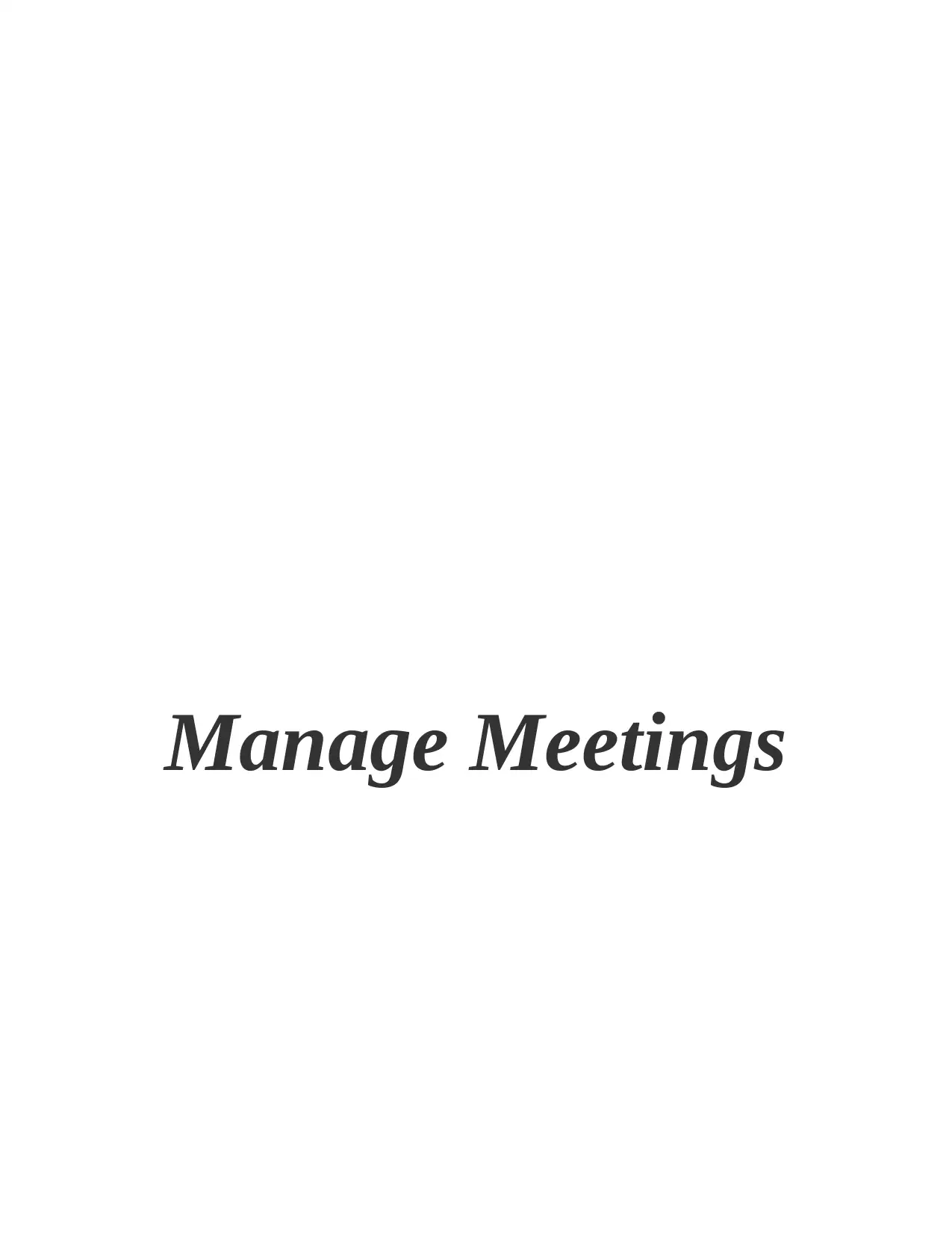
Manage Meetings
Paraphrase This Document
Need a fresh take? Get an instant paraphrase of this document with our AI Paraphraser
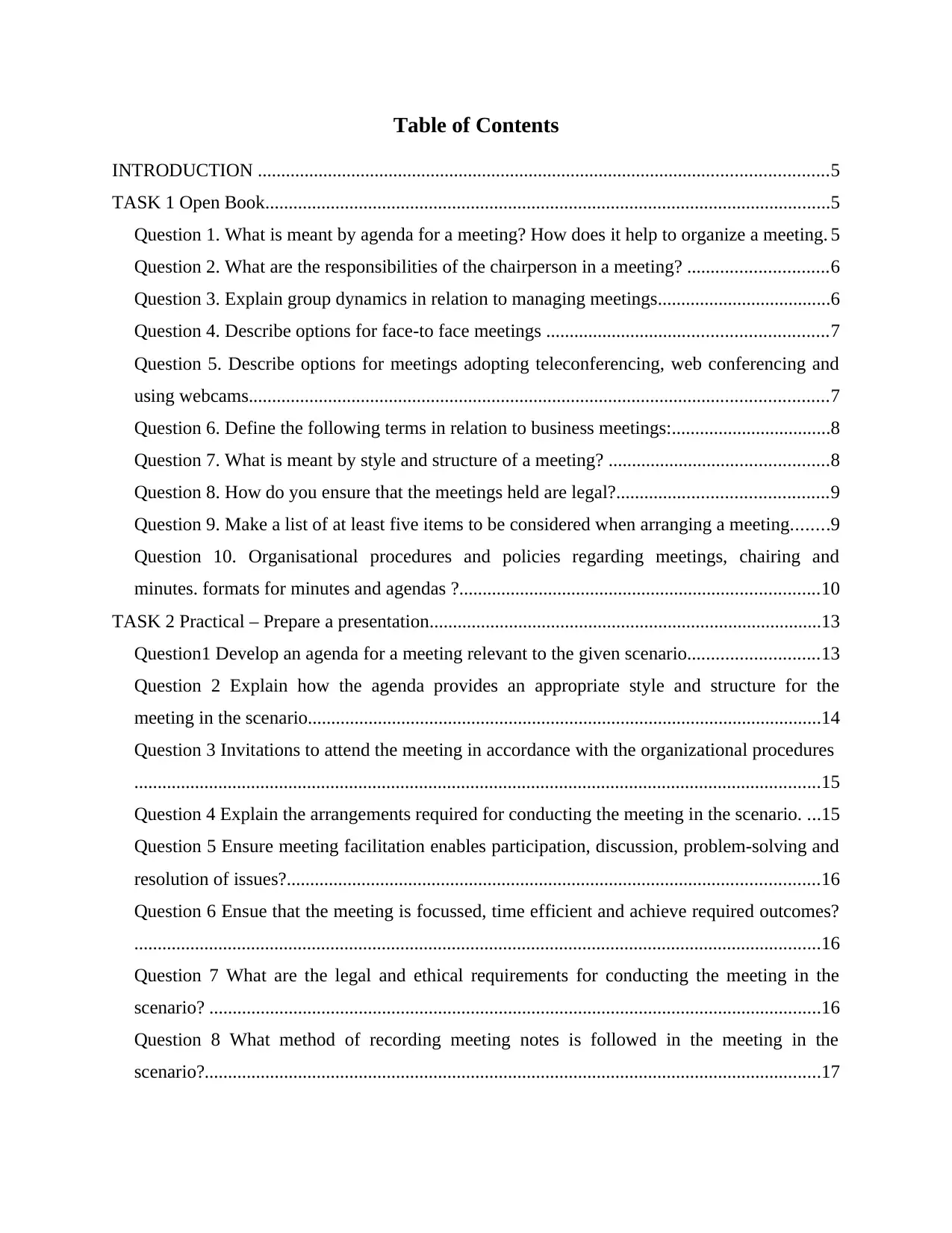
Table of Contents
INTRODUCTION ..........................................................................................................................5
TASK 1 Open Book.........................................................................................................................5
Question 1. What is meant by agenda for a meeting? How does it help to organize a meeting. 5
Question 2. What are the responsibilities of the chairperson in a meeting? ..............................6
Question 3. Explain group dynamics in relation to managing meetings.....................................6
Question 4. Describe options for face-to face meetings ............................................................7
Question 5. Describe options for meetings adopting teleconferencing, web conferencing and
using webcams............................................................................................................................7
Question 6. Define the following terms in relation to business meetings:..................................8
Question 7. What is meant by style and structure of a meeting? ...............................................8
Question 8. How do you ensure that the meetings held are legal?.............................................9
Question 9. Make a list of at least five items to be considered when arranging a meeting........9
Question 10. Organisational procedures and policies regarding meetings, chairing and
minutes. formats for minutes and agendas ?.............................................................................10
TASK 2 Practical – Prepare a presentation....................................................................................13
Question1 Develop an agenda for a meeting relevant to the given scenario............................13
Question 2 Explain how the agenda provides an appropriate style and structure for the
meeting in the scenario..............................................................................................................14
Question 3 Invitations to attend the meeting in accordance with the organizational procedures
...................................................................................................................................................15
Question 4 Explain the arrangements required for conducting the meeting in the scenario. ...15
Question 5 Ensure meeting facilitation enables participation, discussion, problem-solving and
resolution of issues?..................................................................................................................16
Question 6 Ensue that the meeting is focussed, time efficient and achieve required outcomes?
...................................................................................................................................................16
Question 7 What are the legal and ethical requirements for conducting the meeting in the
scenario? ...................................................................................................................................16
Question 8 What method of recording meeting notes is followed in the meeting in the
scenario?....................................................................................................................................17
INTRODUCTION ..........................................................................................................................5
TASK 1 Open Book.........................................................................................................................5
Question 1. What is meant by agenda for a meeting? How does it help to organize a meeting. 5
Question 2. What are the responsibilities of the chairperson in a meeting? ..............................6
Question 3. Explain group dynamics in relation to managing meetings.....................................6
Question 4. Describe options for face-to face meetings ............................................................7
Question 5. Describe options for meetings adopting teleconferencing, web conferencing and
using webcams............................................................................................................................7
Question 6. Define the following terms in relation to business meetings:..................................8
Question 7. What is meant by style and structure of a meeting? ...............................................8
Question 8. How do you ensure that the meetings held are legal?.............................................9
Question 9. Make a list of at least five items to be considered when arranging a meeting........9
Question 10. Organisational procedures and policies regarding meetings, chairing and
minutes. formats for minutes and agendas ?.............................................................................10
TASK 2 Practical – Prepare a presentation....................................................................................13
Question1 Develop an agenda for a meeting relevant to the given scenario............................13
Question 2 Explain how the agenda provides an appropriate style and structure for the
meeting in the scenario..............................................................................................................14
Question 3 Invitations to attend the meeting in accordance with the organizational procedures
...................................................................................................................................................15
Question 4 Explain the arrangements required for conducting the meeting in the scenario. ...15
Question 5 Ensure meeting facilitation enables participation, discussion, problem-solving and
resolution of issues?..................................................................................................................16
Question 6 Ensue that the meeting is focussed, time efficient and achieve required outcomes?
...................................................................................................................................................16
Question 7 What are the legal and ethical requirements for conducting the meeting in the
scenario? ...................................................................................................................................16
Question 8 What method of recording meeting notes is followed in the meeting in the
scenario?....................................................................................................................................17
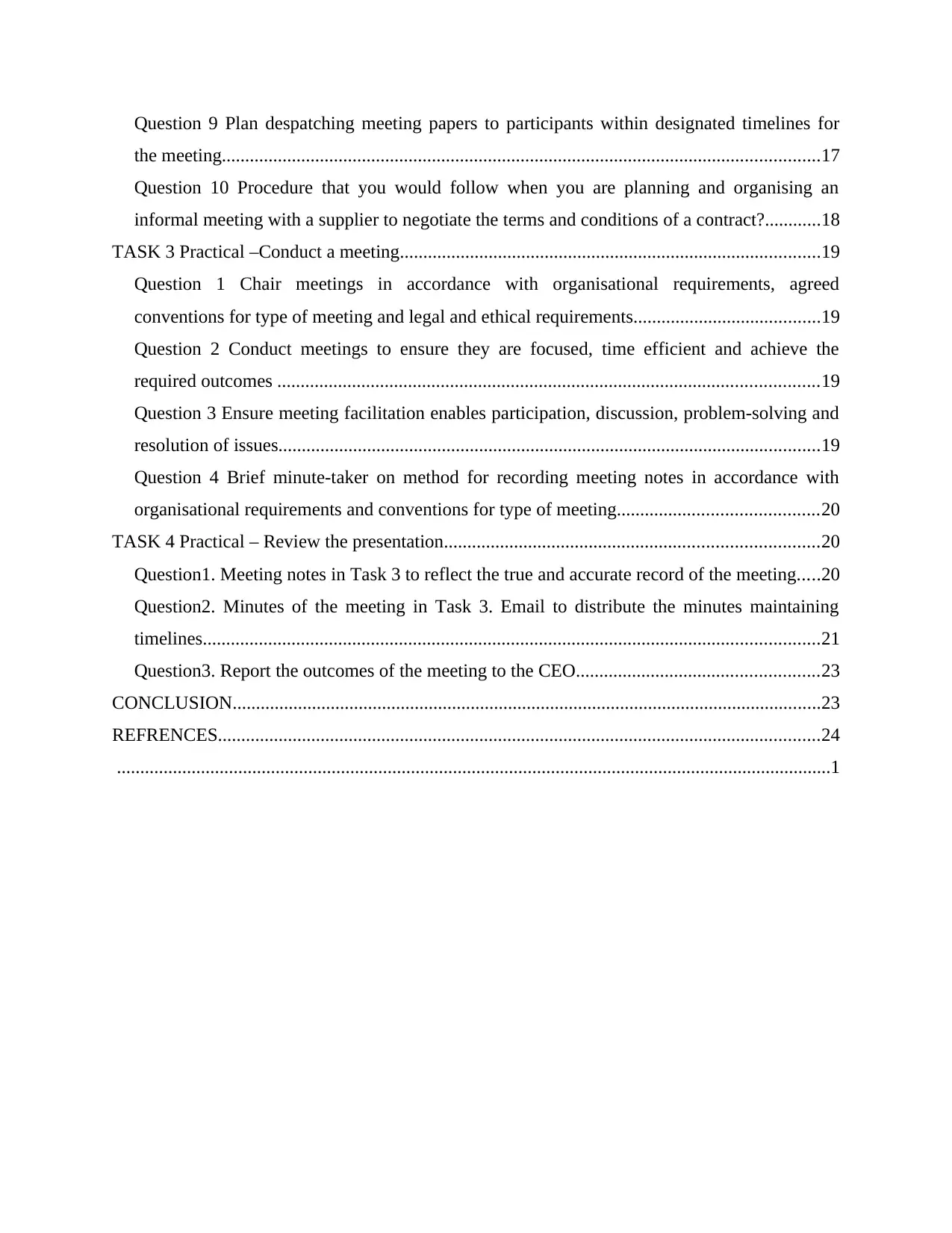
Question 9 Plan despatching meeting papers to participants within designated timelines for
the meeting................................................................................................................................17
Question 10 Procedure that you would follow when you are planning and organising an
informal meeting with a supplier to negotiate the terms and conditions of a contract?............18
TASK 3 Practical –Conduct a meeting..........................................................................................19
Question 1 Chair meetings in accordance with organisational requirements, agreed
conventions for type of meeting and legal and ethical requirements........................................19
Question 2 Conduct meetings to ensure they are focused, time efficient and achieve the
required outcomes ....................................................................................................................19
Question 3 Ensure meeting facilitation enables participation, discussion, problem-solving and
resolution of issues....................................................................................................................19
Question 4 Brief minute-taker on method for recording meeting notes in accordance with
organisational requirements and conventions for type of meeting...........................................20
TASK 4 Practical – Review the presentation................................................................................20
Question1. Meeting notes in Task 3 to reflect the true and accurate record of the meeting.....20
Question2. Minutes of the meeting in Task 3. Email to distribute the minutes maintaining
timelines....................................................................................................................................21
Question3. Report the outcomes of the meeting to the CEO....................................................23
CONCLUSION..............................................................................................................................23
REFRENCES.................................................................................................................................24
.........................................................................................................................................................1
the meeting................................................................................................................................17
Question 10 Procedure that you would follow when you are planning and organising an
informal meeting with a supplier to negotiate the terms and conditions of a contract?............18
TASK 3 Practical –Conduct a meeting..........................................................................................19
Question 1 Chair meetings in accordance with organisational requirements, agreed
conventions for type of meeting and legal and ethical requirements........................................19
Question 2 Conduct meetings to ensure they are focused, time efficient and achieve the
required outcomes ....................................................................................................................19
Question 3 Ensure meeting facilitation enables participation, discussion, problem-solving and
resolution of issues....................................................................................................................19
Question 4 Brief minute-taker on method for recording meeting notes in accordance with
organisational requirements and conventions for type of meeting...........................................20
TASK 4 Practical – Review the presentation................................................................................20
Question1. Meeting notes in Task 3 to reflect the true and accurate record of the meeting.....20
Question2. Minutes of the meeting in Task 3. Email to distribute the minutes maintaining
timelines....................................................................................................................................21
Question3. Report the outcomes of the meeting to the CEO....................................................23
CONCLUSION..............................................................................................................................23
REFRENCES.................................................................................................................................24
.........................................................................................................................................................1
⊘ This is a preview!⊘
Do you want full access?
Subscribe today to unlock all pages.

Trusted by 1+ million students worldwide
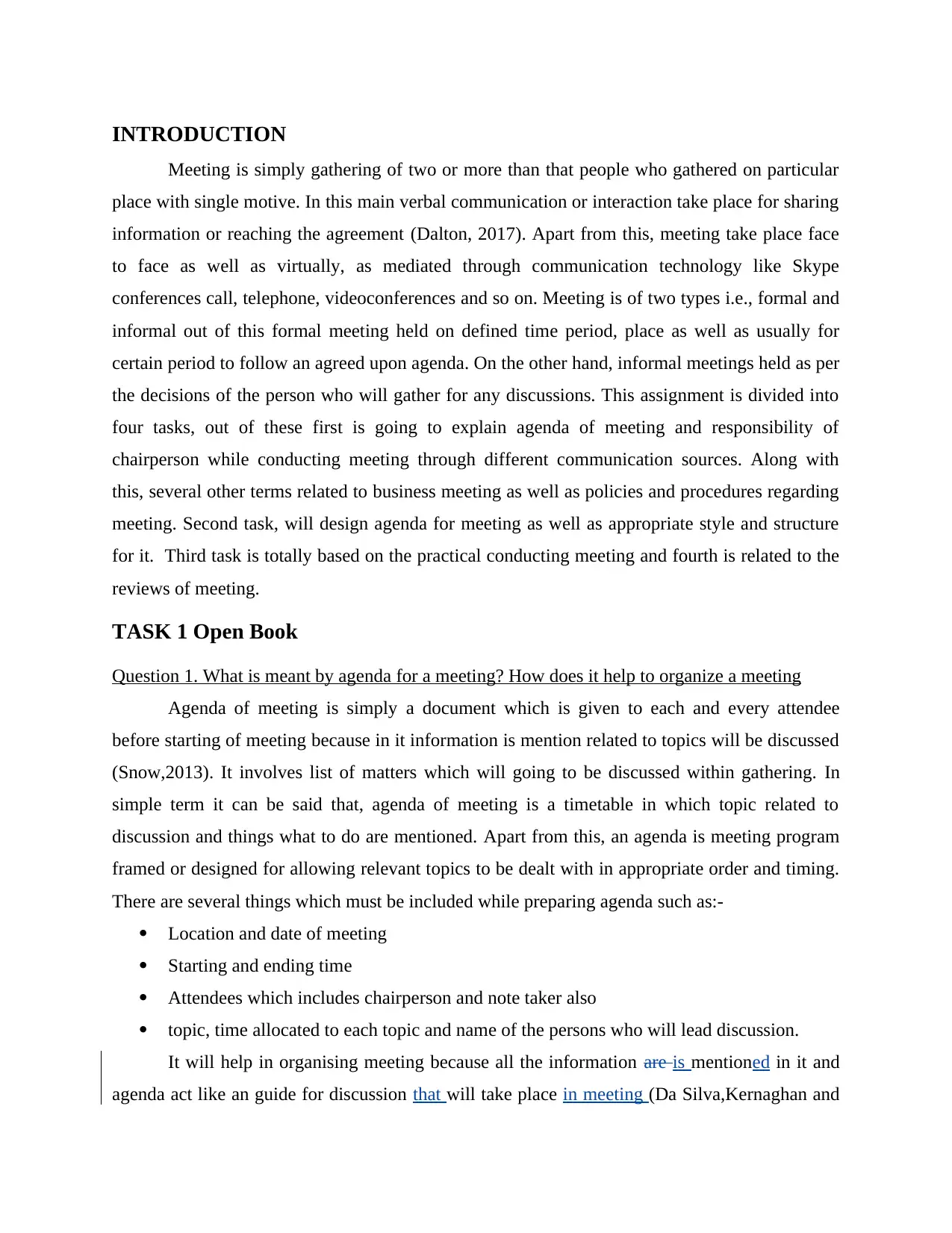
INTRODUCTION
Meeting is simply gathering of two or more than that people who gathered on particular
place with single motive. In this main verbal communication or interaction take place for sharing
information or reaching the agreement (Dalton, 2017). Apart from this, meeting take place face
to face as well as virtually, as mediated through communication technology like Skype
conferences call, telephone, videoconferences and so on. Meeting is of two types i.e., formal and
informal out of this formal meeting held on defined time period, place as well as usually for
certain period to follow an agreed upon agenda. On the other hand, informal meetings held as per
the decisions of the person who will gather for any discussions. This assignment is divided into
four tasks, out of these first is going to explain agenda of meeting and responsibility of
chairperson while conducting meeting through different communication sources. Along with
this, several other terms related to business meeting as well as policies and procedures regarding
meeting. Second task, will design agenda for meeting as well as appropriate style and structure
for it. Third task is totally based on the practical conducting meeting and fourth is related to the
reviews of meeting.
TASK 1 Open Book
Question 1. What is meant by agenda for a meeting? How does it help to organize a meeting
Agenda of meeting is simply a document which is given to each and every attendee
before starting of meeting because in it information is mention related to topics will be discussed
(Snow,2013). It involves list of matters which will going to be discussed within gathering. In
simple term it can be said that, agenda of meeting is a timetable in which topic related to
discussion and things what to do are mentioned. Apart from this, an agenda is meeting program
framed or designed for allowing relevant topics to be dealt with in appropriate order and timing.
There are several things which must be included while preparing agenda such as:-
Location and date of meeting
Starting and ending time
Attendees which includes chairperson and note taker also
topic, time allocated to each topic and name of the persons who will lead discussion.
It will help in organising meeting because all the information are is mentioned in it and
agenda act like an guide for discussion that will take place in meeting (Da Silva,Kernaghan and
Meeting is simply gathering of two or more than that people who gathered on particular
place with single motive. In this main verbal communication or interaction take place for sharing
information or reaching the agreement (Dalton, 2017). Apart from this, meeting take place face
to face as well as virtually, as mediated through communication technology like Skype
conferences call, telephone, videoconferences and so on. Meeting is of two types i.e., formal and
informal out of this formal meeting held on defined time period, place as well as usually for
certain period to follow an agreed upon agenda. On the other hand, informal meetings held as per
the decisions of the person who will gather for any discussions. This assignment is divided into
four tasks, out of these first is going to explain agenda of meeting and responsibility of
chairperson while conducting meeting through different communication sources. Along with
this, several other terms related to business meeting as well as policies and procedures regarding
meeting. Second task, will design agenda for meeting as well as appropriate style and structure
for it. Third task is totally based on the practical conducting meeting and fourth is related to the
reviews of meeting.
TASK 1 Open Book
Question 1. What is meant by agenda for a meeting? How does it help to organize a meeting
Agenda of meeting is simply a document which is given to each and every attendee
before starting of meeting because in it information is mention related to topics will be discussed
(Snow,2013). It involves list of matters which will going to be discussed within gathering. In
simple term it can be said that, agenda of meeting is a timetable in which topic related to
discussion and things what to do are mentioned. Apart from this, an agenda is meeting program
framed or designed for allowing relevant topics to be dealt with in appropriate order and timing.
There are several things which must be included while preparing agenda such as:-
Location and date of meeting
Starting and ending time
Attendees which includes chairperson and note taker also
topic, time allocated to each topic and name of the persons who will lead discussion.
It will help in organising meeting because all the information are is mentioned in it and
agenda act like an guide for discussion that will take place in meeting (Da Silva,Kernaghan and
Paraphrase This Document
Need a fresh take? Get an instant paraphrase of this document with our AI Paraphraser
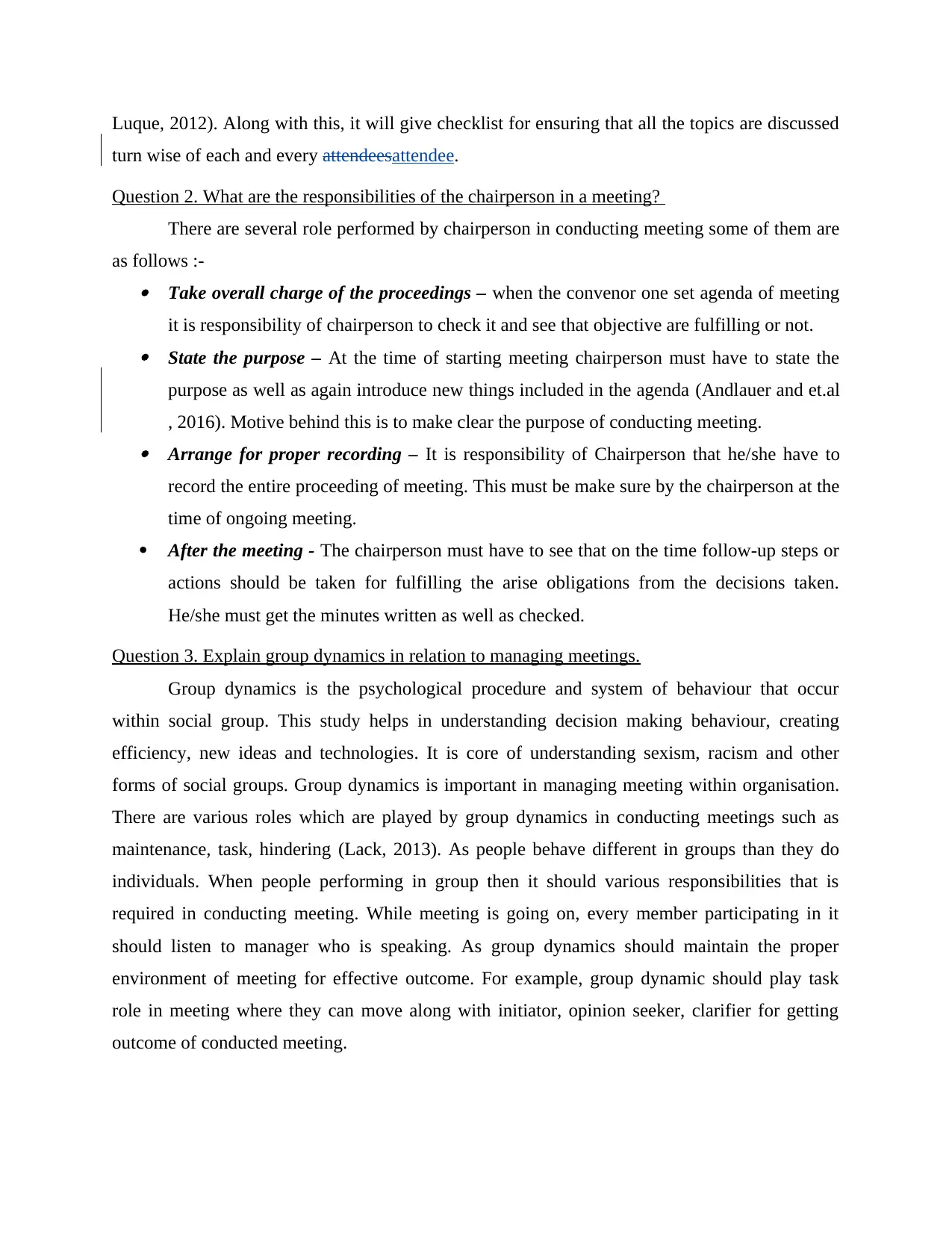
Luque, 2012). Along with this, it will give checklist for ensuring that all the topics are discussed
turn wise of each and every attendeesattendee.
Question 2. What are the responsibilities of the chairperson in a meeting?
There are several role performed by chairperson in conducting meeting some of them are
as follows :- Take overall charge of the proceedings – when the convenor one set agenda of meeting
it is responsibility of chairperson to check it and see that objective are fulfilling or not. State the purpose – At the time of starting meeting chairperson must have to state the
purpose as well as again introduce new things included in the agenda (Andlauer and et.al
, 2016). Motive behind this is to make clear the purpose of conducting meeting. Arrange for proper recording – It is responsibility of Chairperson that he/she have to
record the entire proceeding of meeting. This must be make sure by the chairperson at the
time of ongoing meeting.
After the meeting - The chairperson must have to see that on the time follow-up steps or
actions should be taken for fulfilling the arise obligations from the decisions taken.
He/she must get the minutes written as well as checked.
Question 3. Explain group dynamics in relation to managing meetings.
Group dynamics is the psychological procedure and system of behaviour that occur
within social group. This study helps in understanding decision making behaviour, creating
efficiency, new ideas and technologies. It is core of understanding sexism, racism and other
forms of social groups. Group dynamics is important in managing meeting within organisation.
There are various roles which are played by group dynamics in conducting meetings such as
maintenance, task, hindering (Lack, 2013). As people behave different in groups than they do
individuals. When people performing in group then it should various responsibilities that is
required in conducting meeting. While meeting is going on, every member participating in it
should listen to manager who is speaking. As group dynamics should maintain the proper
environment of meeting for effective outcome. For example, group dynamic should play task
role in meeting where they can move along with initiator, opinion seeker, clarifier for getting
outcome of conducted meeting.
turn wise of each and every attendeesattendee.
Question 2. What are the responsibilities of the chairperson in a meeting?
There are several role performed by chairperson in conducting meeting some of them are
as follows :- Take overall charge of the proceedings – when the convenor one set agenda of meeting
it is responsibility of chairperson to check it and see that objective are fulfilling or not. State the purpose – At the time of starting meeting chairperson must have to state the
purpose as well as again introduce new things included in the agenda (Andlauer and et.al
, 2016). Motive behind this is to make clear the purpose of conducting meeting. Arrange for proper recording – It is responsibility of Chairperson that he/she have to
record the entire proceeding of meeting. This must be make sure by the chairperson at the
time of ongoing meeting.
After the meeting - The chairperson must have to see that on the time follow-up steps or
actions should be taken for fulfilling the arise obligations from the decisions taken.
He/she must get the minutes written as well as checked.
Question 3. Explain group dynamics in relation to managing meetings.
Group dynamics is the psychological procedure and system of behaviour that occur
within social group. This study helps in understanding decision making behaviour, creating
efficiency, new ideas and technologies. It is core of understanding sexism, racism and other
forms of social groups. Group dynamics is important in managing meeting within organisation.
There are various roles which are played by group dynamics in conducting meetings such as
maintenance, task, hindering (Lack, 2013). As people behave different in groups than they do
individuals. When people performing in group then it should various responsibilities that is
required in conducting meeting. While meeting is going on, every member participating in it
should listen to manager who is speaking. As group dynamics should maintain the proper
environment of meeting for effective outcome. For example, group dynamic should play task
role in meeting where they can move along with initiator, opinion seeker, clarifier for getting
outcome of conducted meeting.
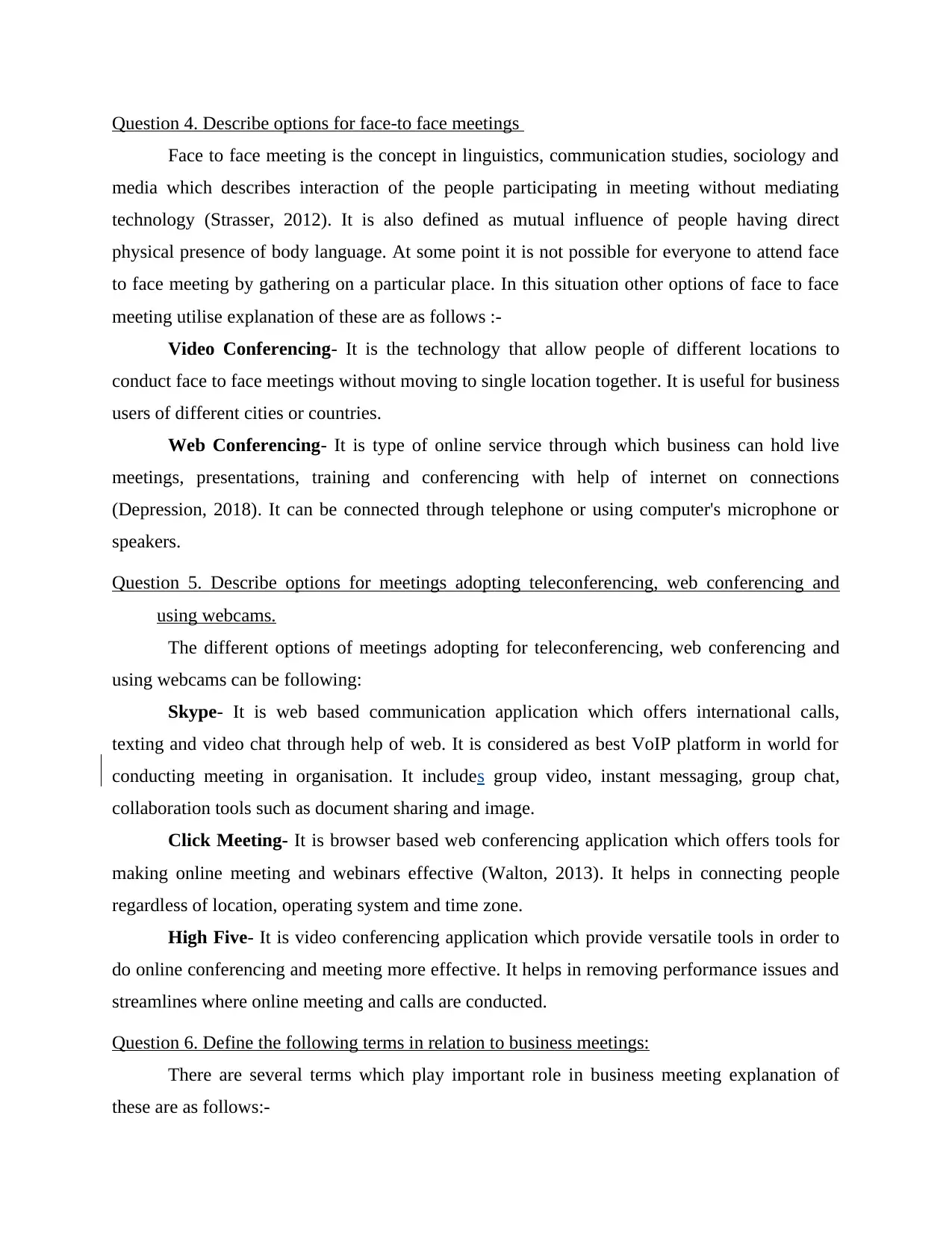
Question 4. Describe options for face-to face meetings
Face to face meeting is the concept in linguistics, communication studies, sociology and
media which describes interaction of the people participating in meeting without mediating
technology (Strasser, 2012). It is also defined as mutual influence of people having direct
physical presence of body language. At some point it is not possible for everyone to attend face
to face meeting by gathering on a particular place. In this situation other options of face to face
meeting utilise explanation of these are as follows :-
Video Conferencing- It is the technology that allow people of different locations to
conduct face to face meetings without moving to single location together. It is useful for business
users of different cities or countries.
Web Conferencing- It is type of online service through which business can hold live
meetings, presentations, training and conferencing with help of internet on connections
(Depression, 2018). It can be connected through telephone or using computer's microphone or
speakers.
Question 5. Describe options for meetings adopting teleconferencing, web conferencing and
using webcams.
The different options of meetings adopting for teleconferencing, web conferencing and
using webcams can be following:
Skype- It is web based communication application which offers international calls,
texting and video chat through help of web. It is considered as best VoIP platform in world for
conducting meeting in organisation. It includes group video, instant messaging, group chat,
collaboration tools such as document sharing and image.
Click Meeting- It is browser based web conferencing application which offers tools for
making online meeting and webinars effective (Walton, 2013). It helps in connecting people
regardless of location, operating system and time zone.
High Five- It is video conferencing application which provide versatile tools in order to
do online conferencing and meeting more effective. It helps in removing performance issues and
streamlines where online meeting and calls are conducted.
Question 6. Define the following terms in relation to business meetings:
There are several terms which play important role in business meeting explanation of
these are as follows:-
Face to face meeting is the concept in linguistics, communication studies, sociology and
media which describes interaction of the people participating in meeting without mediating
technology (Strasser, 2012). It is also defined as mutual influence of people having direct
physical presence of body language. At some point it is not possible for everyone to attend face
to face meeting by gathering on a particular place. In this situation other options of face to face
meeting utilise explanation of these are as follows :-
Video Conferencing- It is the technology that allow people of different locations to
conduct face to face meetings without moving to single location together. It is useful for business
users of different cities or countries.
Web Conferencing- It is type of online service through which business can hold live
meetings, presentations, training and conferencing with help of internet on connections
(Depression, 2018). It can be connected through telephone or using computer's microphone or
speakers.
Question 5. Describe options for meetings adopting teleconferencing, web conferencing and
using webcams.
The different options of meetings adopting for teleconferencing, web conferencing and
using webcams can be following:
Skype- It is web based communication application which offers international calls,
texting and video chat through help of web. It is considered as best VoIP platform in world for
conducting meeting in organisation. It includes group video, instant messaging, group chat,
collaboration tools such as document sharing and image.
Click Meeting- It is browser based web conferencing application which offers tools for
making online meeting and webinars effective (Walton, 2013). It helps in connecting people
regardless of location, operating system and time zone.
High Five- It is video conferencing application which provide versatile tools in order to
do online conferencing and meeting more effective. It helps in removing performance issues and
streamlines where online meeting and calls are conducted.
Question 6. Define the following terms in relation to business meetings:
There are several terms which play important role in business meeting explanation of
these are as follows:-
⊘ This is a preview!⊘
Do you want full access?
Subscribe today to unlock all pages.

Trusted by 1+ million students worldwide
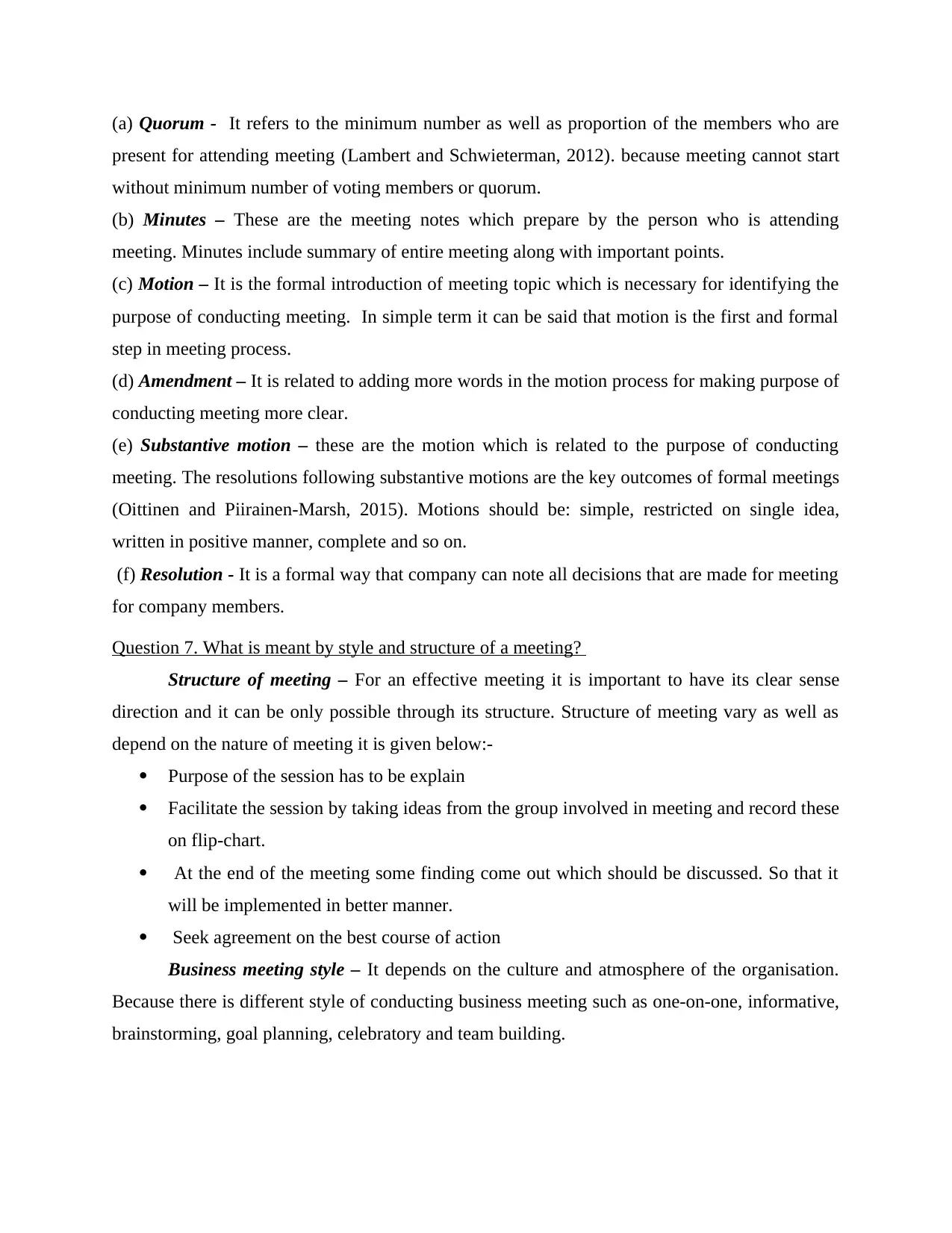
(a) Quorum - It refers to the minimum number as well as proportion of the members who are
present for attending meeting (Lambert and Schwieterman, 2012). because meeting cannot start
without minimum number of voting members or quorum.
(b) Minutes – These are the meeting notes which prepare by the person who is attending
meeting. Minutes include summary of entire meeting along with important points.
(c) Motion – It is the formal introduction of meeting topic which is necessary for identifying the
purpose of conducting meeting. In simple term it can be said that motion is the first and formal
step in meeting process.
(d) Amendment – It is related to adding more words in the motion process for making purpose of
conducting meeting more clear.
(e) Substantive motion – these are the motion which is related to the purpose of conducting
meeting. The resolutions following substantive motions are the key outcomes of formal meetings
(Oittinen and Piirainen-Marsh, 2015). Motions should be: simple, restricted on single idea,
written in positive manner, complete and so on.
(f) Resolution - It is a formal way that company can note all decisions that are made for meeting
for company members.
Question 7. What is meant by style and structure of a meeting?
Structure of meeting – For an effective meeting it is important to have its clear sense
direction and it can be only possible through its structure. Structure of meeting vary as well as
depend on the nature of meeting it is given below:-
Purpose of the session has to be explain
Facilitate the session by taking ideas from the group involved in meeting and record these
on flip-chart.
At the end of the meeting some finding come out which should be discussed. So that it
will be implemented in better manner.
Seek agreement on the best course of action
Business meeting style – It depends on the culture and atmosphere of the organisation.
Because there is different style of conducting business meeting such as one-on-one, informative,
brainstorming, goal planning, celebratory and team building.
present for attending meeting (Lambert and Schwieterman, 2012). because meeting cannot start
without minimum number of voting members or quorum.
(b) Minutes – These are the meeting notes which prepare by the person who is attending
meeting. Minutes include summary of entire meeting along with important points.
(c) Motion – It is the formal introduction of meeting topic which is necessary for identifying the
purpose of conducting meeting. In simple term it can be said that motion is the first and formal
step in meeting process.
(d) Amendment – It is related to adding more words in the motion process for making purpose of
conducting meeting more clear.
(e) Substantive motion – these are the motion which is related to the purpose of conducting
meeting. The resolutions following substantive motions are the key outcomes of formal meetings
(Oittinen and Piirainen-Marsh, 2015). Motions should be: simple, restricted on single idea,
written in positive manner, complete and so on.
(f) Resolution - It is a formal way that company can note all decisions that are made for meeting
for company members.
Question 7. What is meant by style and structure of a meeting?
Structure of meeting – For an effective meeting it is important to have its clear sense
direction and it can be only possible through its structure. Structure of meeting vary as well as
depend on the nature of meeting it is given below:-
Purpose of the session has to be explain
Facilitate the session by taking ideas from the group involved in meeting and record these
on flip-chart.
At the end of the meeting some finding come out which should be discussed. So that it
will be implemented in better manner.
Seek agreement on the best course of action
Business meeting style – It depends on the culture and atmosphere of the organisation.
Because there is different style of conducting business meeting such as one-on-one, informative,
brainstorming, goal planning, celebratory and team building.
Paraphrase This Document
Need a fresh take? Get an instant paraphrase of this document with our AI Paraphraser
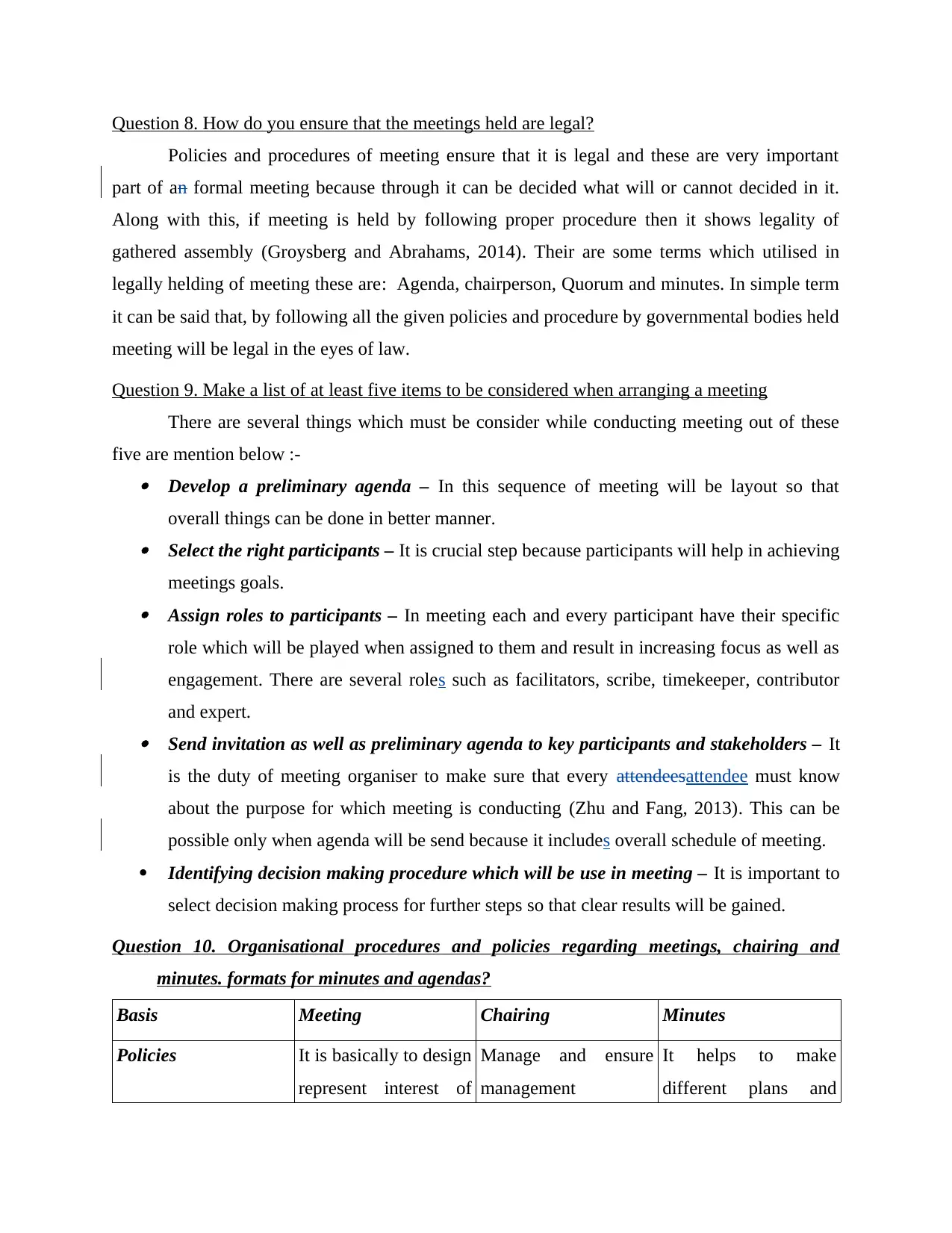
Question 8. How do you ensure that the meetings held are legal?
Policies and procedures of meeting ensure that it is legal and these are very important
part of an formal meeting because through it can be decided what will or cannot decided in it.
Along with this, if meeting is held by following proper procedure then it shows legality of
gathered assembly (Groysberg and Abrahams, 2014). Their are some terms which utilised in
legally helding of meeting these are: Agenda, chairperson, Quorum and minutes. In simple term
it can be said that, by following all the given policies and procedure by governmental bodies held
meeting will be legal in the eyes of law.
Question 9. Make a list of at least five items to be considered when arranging a meeting
There are several things which must be consider while conducting meeting out of these
five are mention below :- Develop a preliminary agenda – In this sequence of meeting will be layout so that
overall things can be done in better manner. Select the right participants – It is crucial step because participants will help in achieving
meetings goals. Assign roles to participants – In meeting each and every participant have their specific
role which will be played when assigned to them and result in increasing focus as well as
engagement. There are several roles such as facilitators, scribe, timekeeper, contributor
and expert. Send invitation as well as preliminary agenda to key participants and stakeholders – It
is the duty of meeting organiser to make sure that every attendeesattendee must know
about the purpose for which meeting is conducting (Zhu and Fang, 2013). This can be
possible only when agenda will be send because it includes overall schedule of meeting.
Identifying decision making procedure which will be use in meeting – It is important to
select decision making process for further steps so that clear results will be gained.
Question 10. Organisational procedures and policies regarding meetings, chairing and
minutes. formats for minutes and agendas?
Basis Meeting Chairing Minutes
Policies It is basically to design
represent interest of
Manage and ensure
management
It helps to make
different plans and
Policies and procedures of meeting ensure that it is legal and these are very important
part of an formal meeting because through it can be decided what will or cannot decided in it.
Along with this, if meeting is held by following proper procedure then it shows legality of
gathered assembly (Groysberg and Abrahams, 2014). Their are some terms which utilised in
legally helding of meeting these are: Agenda, chairperson, Quorum and minutes. In simple term
it can be said that, by following all the given policies and procedure by governmental bodies held
meeting will be legal in the eyes of law.
Question 9. Make a list of at least five items to be considered when arranging a meeting
There are several things which must be consider while conducting meeting out of these
five are mention below :- Develop a preliminary agenda – In this sequence of meeting will be layout so that
overall things can be done in better manner. Select the right participants – It is crucial step because participants will help in achieving
meetings goals. Assign roles to participants – In meeting each and every participant have their specific
role which will be played when assigned to them and result in increasing focus as well as
engagement. There are several roles such as facilitators, scribe, timekeeper, contributor
and expert. Send invitation as well as preliminary agenda to key participants and stakeholders – It
is the duty of meeting organiser to make sure that every attendeesattendee must know
about the purpose for which meeting is conducting (Zhu and Fang, 2013). This can be
possible only when agenda will be send because it includes overall schedule of meeting.
Identifying decision making procedure which will be use in meeting – It is important to
select decision making process for further steps so that clear results will be gained.
Question 10. Organisational procedures and policies regarding meetings, chairing and
minutes. formats for minutes and agendas?
Basis Meeting Chairing Minutes
Policies It is basically to design
represent interest of
Manage and ensure
management
It helps to make
different plans and
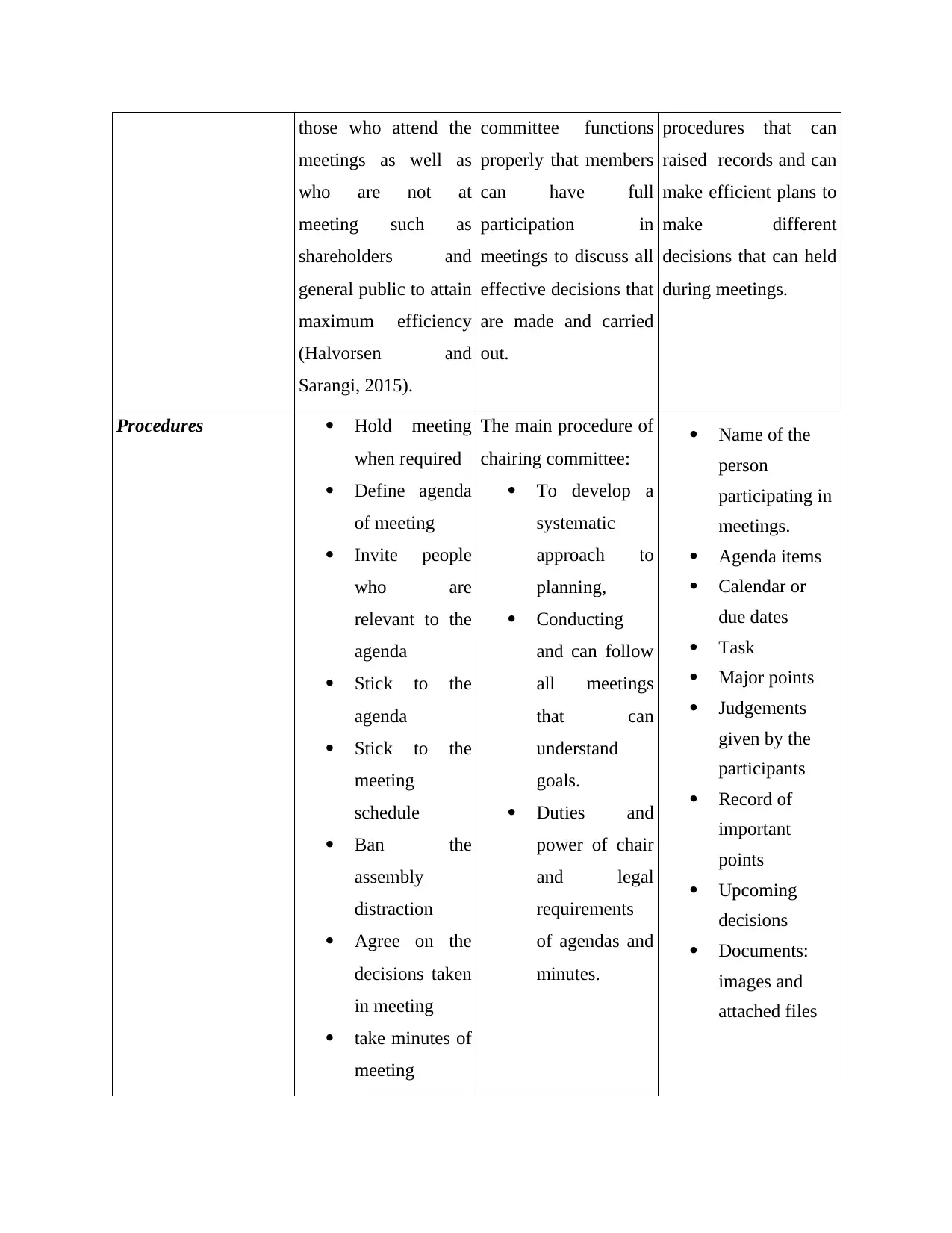
those who attend the
meetings as well as
who are not at
meeting such as
shareholders and
general public to attain
maximum efficiency
(Halvorsen and
Sarangi, 2015).
committee functions
properly that members
can have full
participation in
meetings to discuss all
effective decisions that
are made and carried
out.
procedures that can
raised records and can
make efficient plans to
make different
decisions that can held
during meetings.
Procedures Hold meeting
when required
Define agenda
of meeting
Invite people
who are
relevant to the
agenda
Stick to the
agenda
Stick to the
meeting
schedule
Ban the
assembly
distraction
Agree on the
decisions taken
in meeting
take minutes of
meeting
The main procedure of
chairing committee:
To develop a
systematic
approach to
planning,
Conducting
and can follow
all meetings
that can
understand
goals.
Duties and
power of chair
and legal
requirements
of agendas and
minutes.
Name of the
person
participating in
meetings.
Agenda items
Calendar or
due dates
Task
Major points
Judgements
given by the
participants
Record of
important
points
Upcoming
decisions
Documents:
images and
attached files
meetings as well as
who are not at
meeting such as
shareholders and
general public to attain
maximum efficiency
(Halvorsen and
Sarangi, 2015).
committee functions
properly that members
can have full
participation in
meetings to discuss all
effective decisions that
are made and carried
out.
procedures that can
raised records and can
make efficient plans to
make different
decisions that can held
during meetings.
Procedures Hold meeting
when required
Define agenda
of meeting
Invite people
who are
relevant to the
agenda
Stick to the
agenda
Stick to the
meeting
schedule
Ban the
assembly
distraction
Agree on the
decisions taken
in meeting
take minutes of
meeting
The main procedure of
chairing committee:
To develop a
systematic
approach to
planning,
Conducting
and can follow
all meetings
that can
understand
goals.
Duties and
power of chair
and legal
requirements
of agendas and
minutes.
Name of the
person
participating in
meetings.
Agenda items
Calendar or
due dates
Task
Major points
Judgements
given by the
participants
Record of
important
points
Upcoming
decisions
Documents:
images and
attached files
⊘ This is a preview!⊘
Do you want full access?
Subscribe today to unlock all pages.

Trusted by 1+ million students worldwide
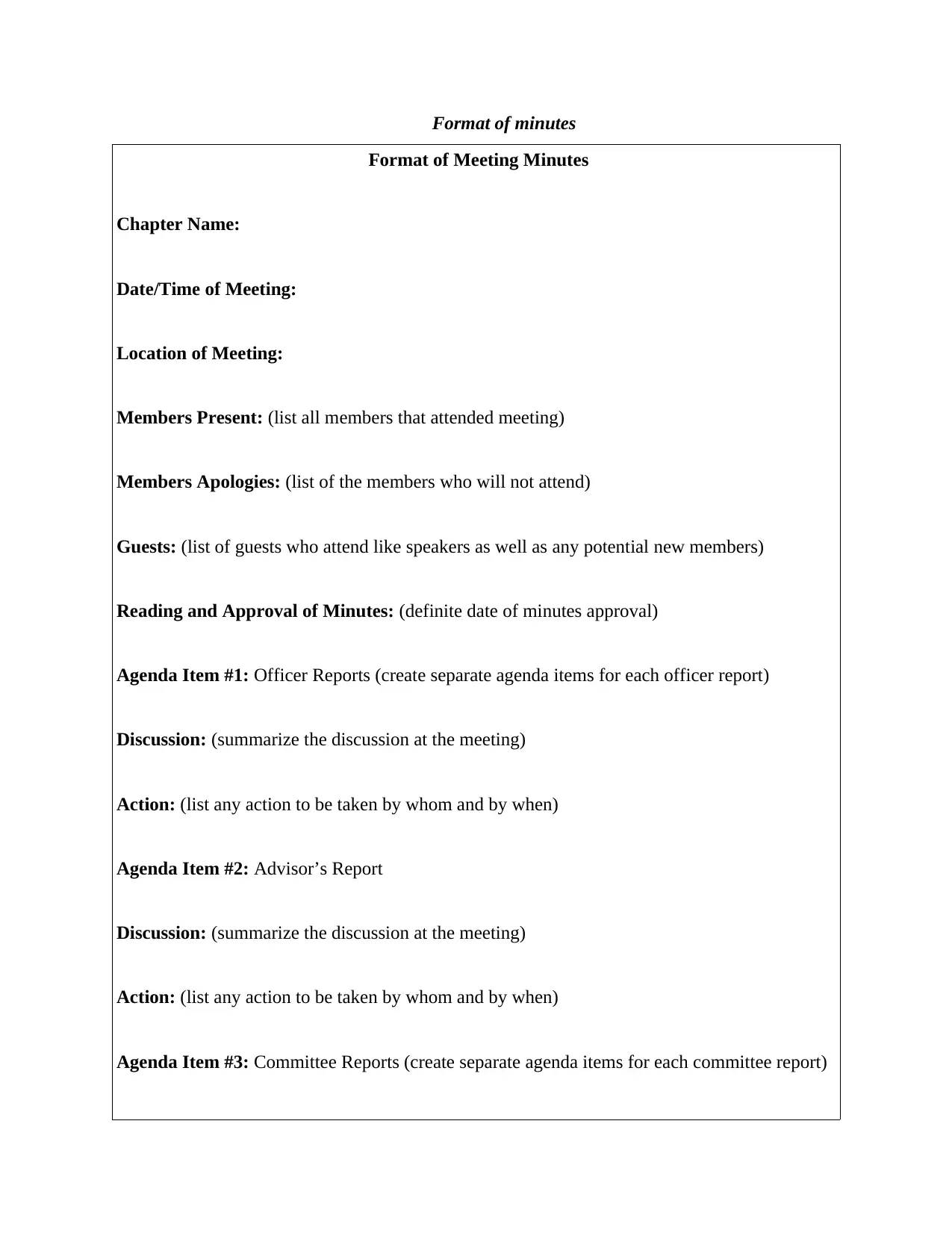
Format of minutes
Format of Meeting Minutes
Chapter Name:
Date/Time of Meeting:
Location of Meeting:
Members Present: (list all members that attended meeting)
Members Apologies: (list of the members who will not attend)
Guests: (list of guests who attend like speakers as well as any potential new members)
Reading and Approval of Minutes: (definite date of minutes approval)
Agenda Item #1: Officer Reports (create separate agenda items for each officer report)
Discussion: (summarize the discussion at the meeting)
Action: (list any action to be taken by whom and by when)
Agenda Item #2: Advisor’s Report
Discussion: (summarize the discussion at the meeting)
Action: (list any action to be taken by whom and by when)
Agenda Item #3: Committee Reports (create separate agenda items for each committee report)
Format of Meeting Minutes
Chapter Name:
Date/Time of Meeting:
Location of Meeting:
Members Present: (list all members that attended meeting)
Members Apologies: (list of the members who will not attend)
Guests: (list of guests who attend like speakers as well as any potential new members)
Reading and Approval of Minutes: (definite date of minutes approval)
Agenda Item #1: Officer Reports (create separate agenda items for each officer report)
Discussion: (summarize the discussion at the meeting)
Action: (list any action to be taken by whom and by when)
Agenda Item #2: Advisor’s Report
Discussion: (summarize the discussion at the meeting)
Action: (list any action to be taken by whom and by when)
Agenda Item #3: Committee Reports (create separate agenda items for each committee report)
Paraphrase This Document
Need a fresh take? Get an instant paraphrase of this document with our AI Paraphraser
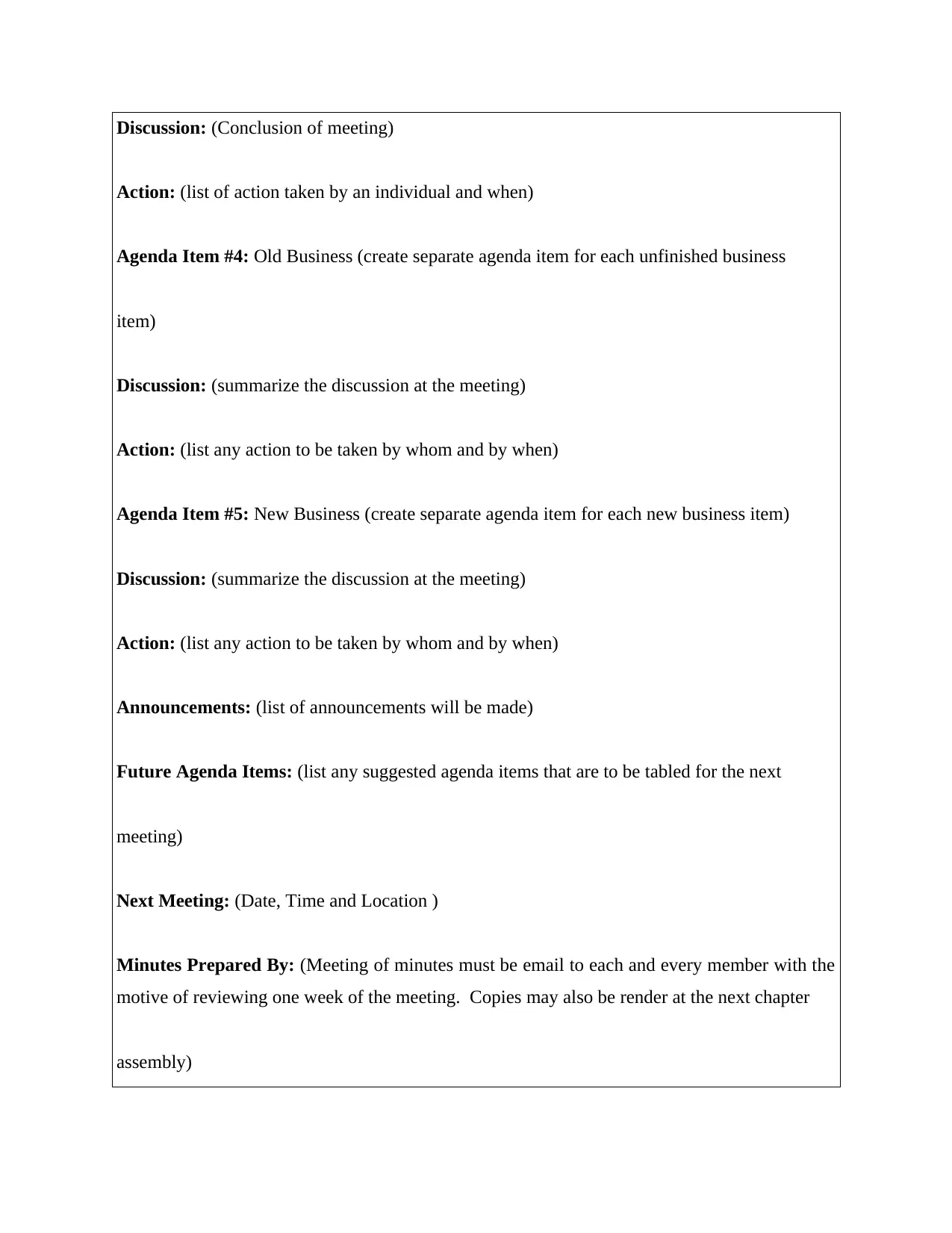
Discussion: (Conclusion of meeting)
Action: (list of action taken by an individual and when)
Agenda Item #4: Old Business (create separate agenda item for each unfinished business
item)
Discussion: (summarize the discussion at the meeting)
Action: (list any action to be taken by whom and by when)
Agenda Item #5: New Business (create separate agenda item for each new business item)
Discussion: (summarize the discussion at the meeting)
Action: (list any action to be taken by whom and by when)
Announcements: (list of announcements will be made)
Future Agenda Items: (list any suggested agenda items that are to be tabled for the next
meeting)
Next Meeting: (Date, Time and Location )
Minutes Prepared By: (Meeting of minutes must be email to each and every member with the
motive of reviewing one week of the meeting. Copies may also be render at the next chapter
assembly)
Action: (list of action taken by an individual and when)
Agenda Item #4: Old Business (create separate agenda item for each unfinished business
item)
Discussion: (summarize the discussion at the meeting)
Action: (list any action to be taken by whom and by when)
Agenda Item #5: New Business (create separate agenda item for each new business item)
Discussion: (summarize the discussion at the meeting)
Action: (list any action to be taken by whom and by when)
Announcements: (list of announcements will be made)
Future Agenda Items: (list any suggested agenda items that are to be tabled for the next
meeting)
Next Meeting: (Date, Time and Location )
Minutes Prepared By: (Meeting of minutes must be email to each and every member with the
motive of reviewing one week of the meeting. Copies may also be render at the next chapter
assembly)
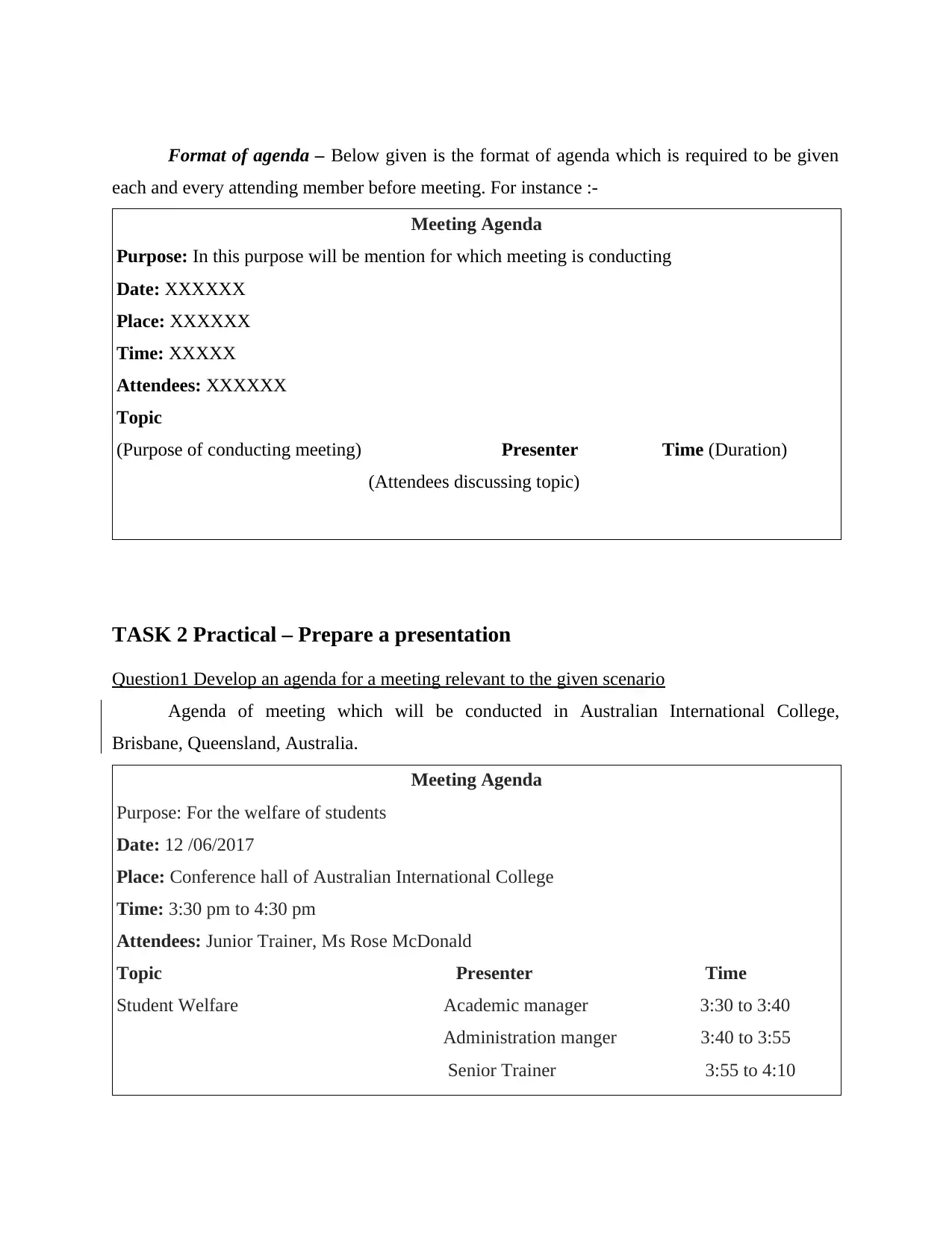
Format of agenda – Below given is the format of agenda which is required to be given
each and every attending member before meeting. For instance :-
Meeting Agenda
Purpose: In this purpose will be mention for which meeting is conducting
Date: XXXXXX
Place: XXXXXX
Time: XXXXX
Attendees: XXXXXX
Topic
(Purpose of conducting meeting) Presenter Time (Duration)
(Attendees discussing topic)
TASK 2 Practical – Prepare a presentation
Question1 Develop an agenda for a meeting relevant to the given scenario
Agenda of meeting which will be conducted in Australian International College,
Brisbane, Queensland, Australia.
Meeting Agenda
Purpose: For the welfare of students
Date: 12 /06/2017
Place: Conference hall of Australian International College
Time: 3:30 pm to 4:30 pm
Attendees: Junior Trainer, Ms Rose McDonald
Topic Presenter Time
Student Welfare Academic manager 3:30 to 3:40
Administration manger 3:40 to 3:55
Senior Trainer 3:55 to 4:10
each and every attending member before meeting. For instance :-
Meeting Agenda
Purpose: In this purpose will be mention for which meeting is conducting
Date: XXXXXX
Place: XXXXXX
Time: XXXXX
Attendees: XXXXXX
Topic
(Purpose of conducting meeting) Presenter Time (Duration)
(Attendees discussing topic)
TASK 2 Practical – Prepare a presentation
Question1 Develop an agenda for a meeting relevant to the given scenario
Agenda of meeting which will be conducted in Australian International College,
Brisbane, Queensland, Australia.
Meeting Agenda
Purpose: For the welfare of students
Date: 12 /06/2017
Place: Conference hall of Australian International College
Time: 3:30 pm to 4:30 pm
Attendees: Junior Trainer, Ms Rose McDonald
Topic Presenter Time
Student Welfare Academic manager 3:30 to 3:40
Administration manger 3:40 to 3:55
Senior Trainer 3:55 to 4:10
⊘ This is a preview!⊘
Do you want full access?
Subscribe today to unlock all pages.

Trusted by 1+ million students worldwide
1 out of 25
Related Documents
Your All-in-One AI-Powered Toolkit for Academic Success.
+13062052269
info@desklib.com
Available 24*7 on WhatsApp / Email
![[object Object]](/_next/static/media/star-bottom.7253800d.svg)
Unlock your academic potential
Copyright © 2020–2025 A2Z Services. All Rights Reserved. Developed and managed by ZUCOL.





